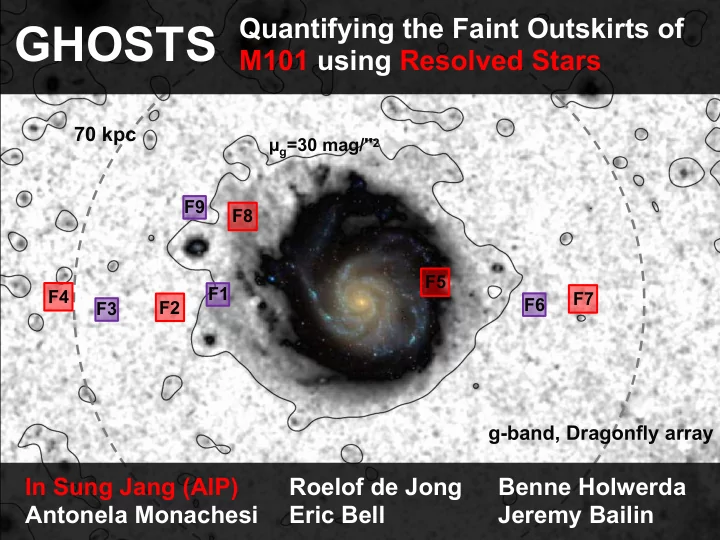

Quantifying the Faint Outskirts of GHOSTS M101 using Resolved Stars 70 kpc µ g =30 mag/'' 2 F9 F8 F5 F1 F4 F7 F6 F2 F3 g-band, Dragonfly array In Sung Jang (AIP) Roelof de Jong Benne Holwerda Antonela Monachesi Eric Bell Jeremy Bailin
CMDs of resolved stars North-East side F814W West side F606W - F814W F814W F9 F8 F606W - F814W F5 F1 F4 F7 F6 F2 F3 East side Empty fields (e.g. HDF) F814W F814W F606W - F814W F606W - F814W
Radial profiles Resolved RGB stars (HST) Integrated light (Dragonfly) F5 F8 F1 F9 F2 F6 F7 F3 F4
Modeling the M101 Halo ✓ Two component fits : Star count Integrated light - An exponential disk . - A power law halo ( α =-3). ✓ The Entire region & the West side : Slight excess at the outer region. ✓ Resolved stars + Integrated light M halo /M gal = ~ 0.5 % ( α =-2~-4) ✓ Integrated light only (Merritt+16) M halo,>5Rh /M gal = 0.04 ± 0.08%
Comparison with observed halos and models N4945 M31 M31 N7814 N891 N253 N7814 N4945 N4565 N253 M81 N891 We compare the halo properties of M101 with those of the six GHOSTS survey galaxies N4565 as well as the Milky Way and M31 and find that M101 has an anemic stellar halo similar MW M81 to the Milky Way. MW The M101 halo marks the low mass & metallicity end of the observed halos, but agrees with the model predictions. � 5 / <Titel (bitte ebenso wie das Datum unter "Einfügen/Kopf-Fußzeile" anpassen)>
Recommend
More recommend